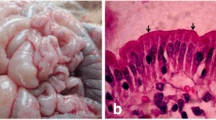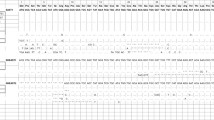Abstract
This study was carried out to determine whether the strong epidemiological correlation observed in Sweden between production of the adhesin K88, the heat-stable (ST) and the heat-labile (LT) enterotoxins inE. coli strains of O-group 149 isolated from piglet diarrhea might be explained by linkage of their genetic determinants. From 22 different isolates plasmids coding for these virulence factors were investigated by conjugation and transduction experiments and analysis on agarose gels. The genes coding for ST production could be transferred by selection for antibiotic resistance, but behaved as transposable elements most often residing on a 55 Mdal plasmid coding for colicin B. The genes coding for raffinose fermentation and K88 antigen production were located on a 45 Mdal plasmid and the genes coding for LT production on plasmids within the 45–70 Mdal size. Thus the epidemiological importance and spread of this O-group in Sweden was explained by its stable content of two or three virulence plasmids, which could be transferred independently of one another.
Similar content being viewed by others
References
Anderson ES (1965) A rapid screening test for transfer factors in drugsensitiveEnterobacteriacae. Nature 208:1016–1020
Bak AL, Christiansen G, Christiansen C, Stenderup A, Ørskov F, Ørskov I (1972) Circular DNA molecules controlling synthesis and transfer of the surface antigen (K88) inEscherichia coli. J Gen Microbiol 73:373–385
Burgess MN, Bywater RJ, Cowley CM, Mullan NA, Newsome PM (1978) Biological evaluation of methanol-soluble, heat-stableEscherichia coli enterotoxin in infant mice, pigs, rabbits and calves. Infect Immun 21:526–531
Dean AG, Ching YC, Williams RG, Harden LB (1972) Test forEscherichia coli enterotoxin using infant mice: application in a study of diarrhoea in children in Honolulu. J Infect Dis 125:407–411
Eriksson H, Sherris Z (1971) Antibiotic sensitivity testing. Report of an international collaborative study. Acta Path Microbiol Scand Sect B, Suppl 217
Evans DJJR, Evans DG, DuPont HL, Ørskov F, Ørskov I (1977) Patterns of loss of enterotoxigenicity byEscherichia coli isolated from Adults with diarrhoea. Suggestive evidence for an interrelationship with serotype. Infect Immun 17:105–111
Frédéricq P (1957) Colicins. A Rev Microbiol 11:7–22
Frydman A, Meynell E (1969) Interactions between de-repressed F-like R-factors and wild type Colicin B factors: superinfection immunity and repressor susceptibility. Genet Res Camb 14:315–332
Gyles CL, So M, Falkow S (1974) The enterotoxin plasmids ofEscherichia coli. J Infect Dis 130:40–49
Gyles CL (1979) Limitations of the infant mouse test forEscherichia coli heat-stable enterotoxin. Canad J Comp Med 13:371–379
Hedén LO, Rutberg L (1976) R Factor-mediated polarized chromosomal transfer inEscherichia coli C. J Bacteriol 127:46–50
Isaacson RE, Moon HW (1978) Distribution and virulence ofEscherichia coli in the small intestines of calves with and without diarrhoea. Am J Vet Res 39:1750–1755
Lennox ES (1955) Transduction of linked genetic characters of the host by the bacteriophage Pl. Virology 1:190–206
Meyers JA, Sanchez D, Elwell LP, Falkow S (1976) Simple agarose gel electrophoretic method for the identification and characterization of plasmid deoxyribonucleic acid. J Bacteriol 127:1529–1537
Meynell GG, Meynell E (1970) Theory and Practice in Experimental Bacteriology 2nd ed, pp 29–37 Cambridge University Press, London.
Mooi FR, de Graaf FK, van Embden JDA (1979) Cloning, mapping and expression of the genetic determinant that encodes for the K88ab antigen. Nucl Acids Res 6:849–865
Olsson E, Söderlind O (1980) Comparison of different assays for definition of heat-stable enterotoxigenicity ofEscherichia coli porcine strains. J Clin Microbiol 11:6–15
Penaranda ME, Mann MB, Evans DG, Evans DJ (1980) Transfer of an ST:L,T:CFA/II plasmid intoEscherichia coli K-12 strain R R 1 by cotransformation with PSC 301 Plasmid DNA. FEMS Microbiol Letters 8:251–254
Shipley PL, Gyles CL, Falkow S (1977) Characterization of plasmids that encode for the K88 colonization antigen. Infect Immun 20:559–568
Smith HR, Cravioto A, Willshav GA, McConnel MM, Scotland SM, Gross RJ, Rowe B (1979) A plasmid coding for the production of colonization factor antigen 1 and heat-stable enterotoxin in strains ofEscherichia coli of serogroup 078. FEMS Microbiol Letters 6:255–260
Smith HW, Gyles CL (1970) The relationship between two apparently different enterotoxins produced by enteropathogenic strains ofEscherichia coli of porcine origin. J Med Microbiol 3:387–401
Smith HW, Parsell Z (1975) Transmissible substrate-utilizing ability inEnterobacteria. J Gen Microbiol 87:129–140
So M, Crosa JH, Falkow S (1975) Polynucleotide sequence relationships among Ent plasmids and the relationship between Ent and other plasmids. J Bacteriol 121:234–238
So M, Dallas WS, Falkow S (1978) Characterization of anEscherichia coli plasmid encoding for synthesis of heat-labile toxin. Molecular cloning of the toxin determinant. Infect Immun 21:405–411
So M, Heffron F, McCarthy BJ (1979) TheE. coli gene encoding heat-stable toxin is a bacterial transposon flanked by inverted repeats of IS1. Nature 277:453–456
Söderlind O (1971) Studies onEscherichia coli in pigs. I. Biochemical investigations. Zentbl VetMed Reihe B 18:489–504
Söderlind O, Möllby R (1978) Studies onEscherichia coli in pigs. V. Determination of enterotoxicity and frequency of O-groups and K88 antigen in strains from 200 piglets with neonatal diarrhoea. Zentbl VetMed Reihe B 25:719–728
Söderlind O, Möllby R (1979) Enterotoxins O-groups and K88 antigen inEscherichia coli from neonatal piglets with and without diarrhoea. Infect Immun 24:611–616
Wiman M, Bertani G, Helly B, Sasaki I (1970) Genetic map ofEscherichia coli strain C. Mol Gen Genet 107:1–31
Author information
Authors and Affiliations
Rights and permissions
About this article
Cite this article
Franklin, A., Söderlind, O. & Möllby, R. Plasmids coding for enterotoxins, K88 antigen and colicins in porcineEscherichia coli strains of O-group 149. Med Microbiol Immunol 170, 63–72 (1981). https://doi.org/10.1007/BF02122670
Received:
Issue Date:
DOI: https://doi.org/10.1007/BF02122670




